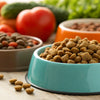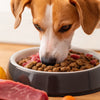How Much Kibble Should a Dog Eat? A Comprehensive Guide for Pet Owners
- Houndsy
Table of Contents
- Introduction
- Factors That Affect How Much Kibble a Dog Should Eat
- General Guidelines on How Much Kibble to Feed Your Dog
- The Importance of Portion Control
- Tools to Help You Determine Your Dog's Feeding Needs
- Making Mealtime Enjoyable
- Conclusion
Introduction
Did you know that approximately 59% of dogs in the United States are classified as overweight or obese? This shocking statistic highlights a significant issue that many pet owners face: determining the right amount of food to feed our beloved dogs. As dog lovers, we understand that feeding our canine companions is not just about filling their bowls; it’s a vital aspect of their health and well-being.
Understanding how much kibble should a dog eat is crucial for maintaining a healthy weight, preventing obesity-related health issues, and promoting longevity. In this blog post, we will explore the various factors that influence your dog's dietary needs, provide guidelines on portion sizes, and introduce tools that can help you determine the perfect serving for your furry friend.
By the end of this comprehensive guide, you will have a clearer understanding of your dog’s nutritional requirements and how to adjust their feeding routine according to their age, size, activity level, and health status. We invite you to reflect on your current feeding practices and consider how you can enhance your dog’s feeding experience.
Let’s dive into the specifics of how much kibble your dog should eat and discover ways to make mealtime a delightful part of your daily routine.
Factors That Affect How Much Kibble a Dog Should Eat
Determining how much kibble your dog should consume daily is not a one-size-fits-all solution. Several key factors influence their caloric needs, and understanding these will help you make informed decisions. Here are the primary factors to consider:
1. Age
Puppies, adult dogs, and senior dogs have different nutritional needs. Puppies require more calories and a specific balance of nutrients to support their rapid growth. Adult dogs maintain a stable caloric intake, while senior dogs often need fewer calories due to a slower metabolism.
- Puppies: Generally need about three times the caloric intake of adult dogs as they grow. This is often around 2-4% of their body weight in food.
- Adult Dogs: Typically require 2-4% of their body weight in food, depending on their activity level.
- Senior Dogs: Usually need fewer calories, around 1.5-2% of their body weight.
2. Size and Breed
The size of your dog plays a significant role in how much kibble they should eat. Smaller breeds have faster metabolisms and may need more calories per pound compared to larger breeds. Here’s a rough breakdown based on size:
- Small Breeds (under 20 lbs): 1/2 to 1 1/2 cups of kibble per day.
- Medium Breeds (20-50 lbs): 1 1/2 to 3 cups.
- Large Breeds (50-100 lbs): 3 to 5 cups.
- Giant Breeds (over 100 lbs): 5 cups and up, adjusting for every additional 10 lbs.
3. Activity Level
A dog's activity level significantly impacts their caloric needs. Active dogs, such as working breeds or those who exercise regularly, will require more food than less active dogs. If your dog is a couch potato, consider reducing their portion size to avoid weight gain.
- Highly Active Dogs: May need 30% more calories.
- Moderately Active Dogs: Stick to standard feeding guidelines.
- Sedentary Dogs: Decrease portions by 10-20%.
4. Body Condition Score
The Body Condition Score (BCS) is a useful tool to assess whether your dog is underweight, at a healthy weight, or overweight. This scoring system, usually on a scale of 1-9, helps determine how much food to give:
- Underweight (1-3): Increase feeding portions gradually.
- Ideal Weight (4-5): Maintain current feeding levels.
- Overweight (6-9): Reduce caloric intake and consult your vet.
5. Health Status
Health conditions can influence your dog's dietary needs. For example, pregnant or nursing dogs require more calories to support their puppies. Additionally, conditions such as diabetes or kidney disease may necessitate a specialized diet, requiring you to consult with your veterinarian.
6. Food Type
Not all kibble is created equal. The calorie density can vary significantly between brands and formulations. Always refer to the feeding guidelines provided on the dog food packaging and adjust based on your dog's specific needs. Foods that are higher in protein and fat may require smaller portions, while lower-calorie options may need larger servings.
General Guidelines on How Much Kibble to Feed Your Dog
To simplify the process of determining how much kibble to serve your dog, we can use general feeding guidelines based on their weight and activity level. Here’s a quick reference chart:
| Dog Weight (lbs) | Daily Kibble (cups) |
|---|---|
| 3-6 lbs | 1/3 - 1/2 |
| 10-20 lbs | 3/4 - 1 1/3 |
| 30-50 lbs | 1 3/4 - 2 2/3 |
| 60-100 lbs | 3 - 4 1/2 |
| Over 100 lbs | 4 1/2 + 1/4 for each additional 10 lbs |
These measurements are approximations, and it is essential to adjust them based on the factors mentioned above.
The Importance of Portion Control
Portion control is critical to maintaining a healthy weight for your dog. Feeding too little can lead to nutritional deficiencies, while overfeeding can result in obesity and associated health risks. The Association for Pet Obesity Prevention notes that obesity can lead to complications such as:
- Joint disease
- Heart problems
- Reduced lifespan
To help manage your dog’s portions effectively, consider the following strategies:
- Use Measuring Cups: Always use a measuring cup to serve kibble, avoiding the temptation to eyeball portions.
- Schedule Regular Feeding Times: Establishing a routine can prevent overfeeding and help regulate your dog’s appetite.
- Monitor Weight Regularly: Weigh your dog at least every month to track changes and adjust feeding accordingly.
Tools to Help You Determine Your Dog's Feeding Needs
With various factors to consider and the potential for miscalculating portions, utilizing tools can simplify the process:
- Feeding Charts: Refer to the feeding guidelines on your dog food packaging for a starting point based on your dog’s weight.
- Calorie Calculators: Online calculators can estimate daily caloric needs based on factors like age, size, and activity level.
- Veterinarian Consultation: Involving your veterinarian in determining your dog’s specific dietary needs is invaluable, especially if your dog has special health considerations.
Making Mealtime Enjoyable
At Houndsy, we believe that mealtime should be a pleasant experience for both you and your dog. Our flagship product, the Houndsy Kibble Dispenser, is designed with convenience and style in mind. It offers perfect portion control, ensuring that your dog receives the right amount of kibble every time. Plus, its mid-century modern design seamlessly integrates with your home decor.
We encourage you to explore the benefits of the Houndsy Kibble Dispenser and elevate your dog feeding experience. Order Now to simplify your daily routine!
Conclusion
Understanding how much kibble your dog should eat is essential for their overall health and happiness. By considering factors such as age, size, activity level, and health status, you can make informed decisions about your dog's diet.
Remember to regularly assess your dog’s body condition and adjust their portions accordingly. With the right tools and knowledge at your disposal, mealtime can become a delightful ritual that strengthens the bond between you and your furry friend.
To enhance your feeding experience further, consider the Houndsy Kibble Dispenser, ensuring convenience and style in every meal. Explore the Houndsy Kibble Dispenser today!
FAQ
1. How often should I feed my dog?
Most adult dogs do well with two meals a day. Puppies may require three to four meals, while seniors might benefit from two smaller meals.
2. Can I free-feed my dog?
Free-feeding can lead to obesity in many dogs. It's often better to stick to scheduled meal times to control portions.
3. What if my dog is not eating their food?
If your dog consistently refuses to eat, consult your veterinarian to rule out health issues.
4. How do I know if my dog is at a healthy weight?
Use the Body Condition Score (BCS) to assess your dog’s weight. A vet can help provide an accurate score.
5. Is it okay to mix wet and dry food?
Yes, mixing wet and dry food can be beneficial, as it adds variety to your dog's diet and encourages hydration.
By implementing these insights and utilizing the Houndsy Kibble Dispenser, we can ensure that our dogs receive the nourishment they need while enjoying a beautiful and convenient feeding experience.













